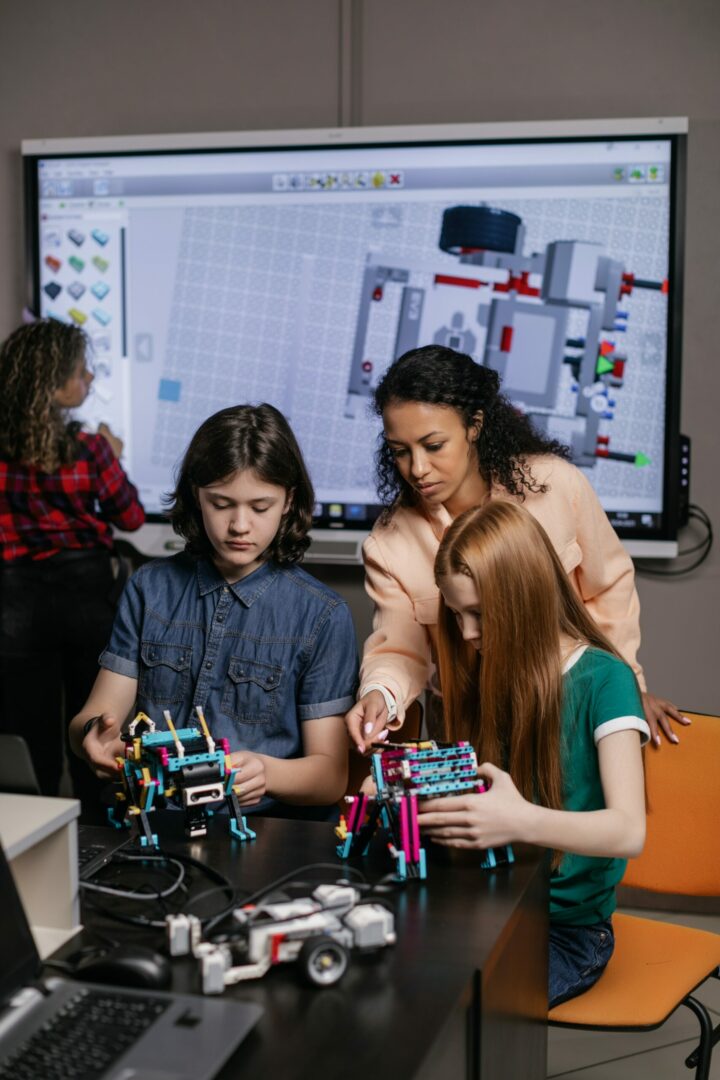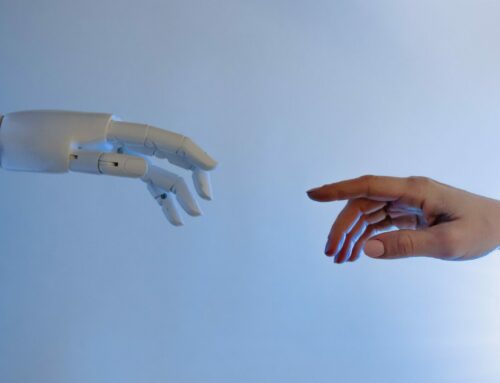Fostering sustainable learning ecosystems
Patrick Blessinger and Madasu Bhaskara Rao
The value of knowledge has grown exponentially over the past several decades. In fact, in the modern era, the value of knowledge has become so important to human and social development that education is now universally recognized as a human right. These three concepts – education, learning, and knowledge – have become inextricably linked. In today’s world, human knowledge is produced primarily through formal learning (institutionalized education such as schools and universities), nonformal learning (self-directed education such as instructional videos, podcasts, blogs, and websites), and informal/incidental learning (everyday life experiences).
Thus, the development of new knowledge happens primarily through one’s prior knowledge and personal experiences. To say that all people have a right to education is to imply that all people have a right to learn and acquire knowledge throughout the entirety of their lives – lifelong and lifewide learning. In fact, knowledge capital (also known as intellectual capital) can be viewed as an intangible asset comprising all the knowledge and skills an individual or group possesses. Furthermore, knowledge may be classified in different ways, such as: factual, conceptual, procedural, and metacognitive.
Structurally, the building blocks of knowledge are data and information. Combining related bits of data (letters, digits, and other characters) yields useful information (words, numbers, and other ideas), which produces expanded forms of knowledge (sentences, equations, and other concepts) which leads to more complete stories, theories, models, and the like. Thus, knowledge builds upon itself – the more meaning we attach to it, the more useful it becomes.
Furthermore, it is the coding and decoding of knowledge through symbols and rules that allow knowledge to be stored and operationalized outside the brain (for example, stored on physical media in analog or digital formats) and used for a great variety of purposes. Thus, the foundation of literacy and numeracy is the ability of humans to code and decode symbols in complex ways – this requires many years of formal education.
Education and learning serve as the foundation for political, economic, social, and technological development. However, one of the major challenges for educational institutions today is to teach students how to discern high-quality knowledge (that is, factual, trustworthy, accurate, and complete) from low-quality knowledge (nonfactual, untrustworthy, inaccurate, incomplete). Before students can become good producers of knowledge, they must first learn how to be good consumers of knowledge.
The shifting paradigm of knowledge
Fortunately for the human race, the human brain is hardwired through evolutionary adaptation for speech (spoken language). As long as children are exposed to sufficient language sounds in the early months and years (critical period) of their development, their brains automatically learn to code and decode speech sounds. As soon as humans are born, they start learning (informally) how to communicate verbally. Humans are able to form their first meaningful words around 12 months of age. In fact, research suggests that babies, while still in the womb (when the auditory system is developed enough for hearing), can distinguish and learn different sounds and speech melodies.
Literacy is the ability to read and write language. Numeracy is the ability to use numbers. Both literacy and numeracy require years of formal education to learn how to code and decode these written symbols and rules. Broadly speaking, in early childhood, one is learning to read, and then in middle childhood, one is reading to learn, and then in late childhood, one is learning to think in more complex and abstract ways – higher-order thinking. Thus, to a large degree, the early years of schooling provide the foundation and set the trajectory for lifelong and lifewide learning.
Knowledge is power because it enables individual empowerment. Therefore, the control of knowledge (as with the control of any valuable resource) has oftentimes been used throughout history as a means to maintain the status quo. However, with the development of the mechanized printing press in Germany (circa 1450 CE), the diffusion of knowledge began to encourage more people to learn to read and write. After the Industrial and Democratic Revolutions of the late 1700s, a critical mass of people began to read and write through the increased presence of schools and universities.
Prior to the Industrial and Democratic Revolutions, there was no universal basic education, and as a result, about 90% of the human population was illiterate. Global literacy has been brought about by the implementation of universal schooling. Today, about 90% of the global population is literate. A literate population is necessary for the proper functioning of a large-scale, complex society.
Furthermore, prior to the widespread industrialization of societies, most people lived on farms and were able to support themselves through agriculture or other forms of subsistence living. Therefore, literacy was not required for survival. However, as society became more industrialized and more democratized, the value of literacy increased concomitantly. As a result, schooling became increasingly important. Knowledge inclusion and education reform have become important aims driving public policy today.
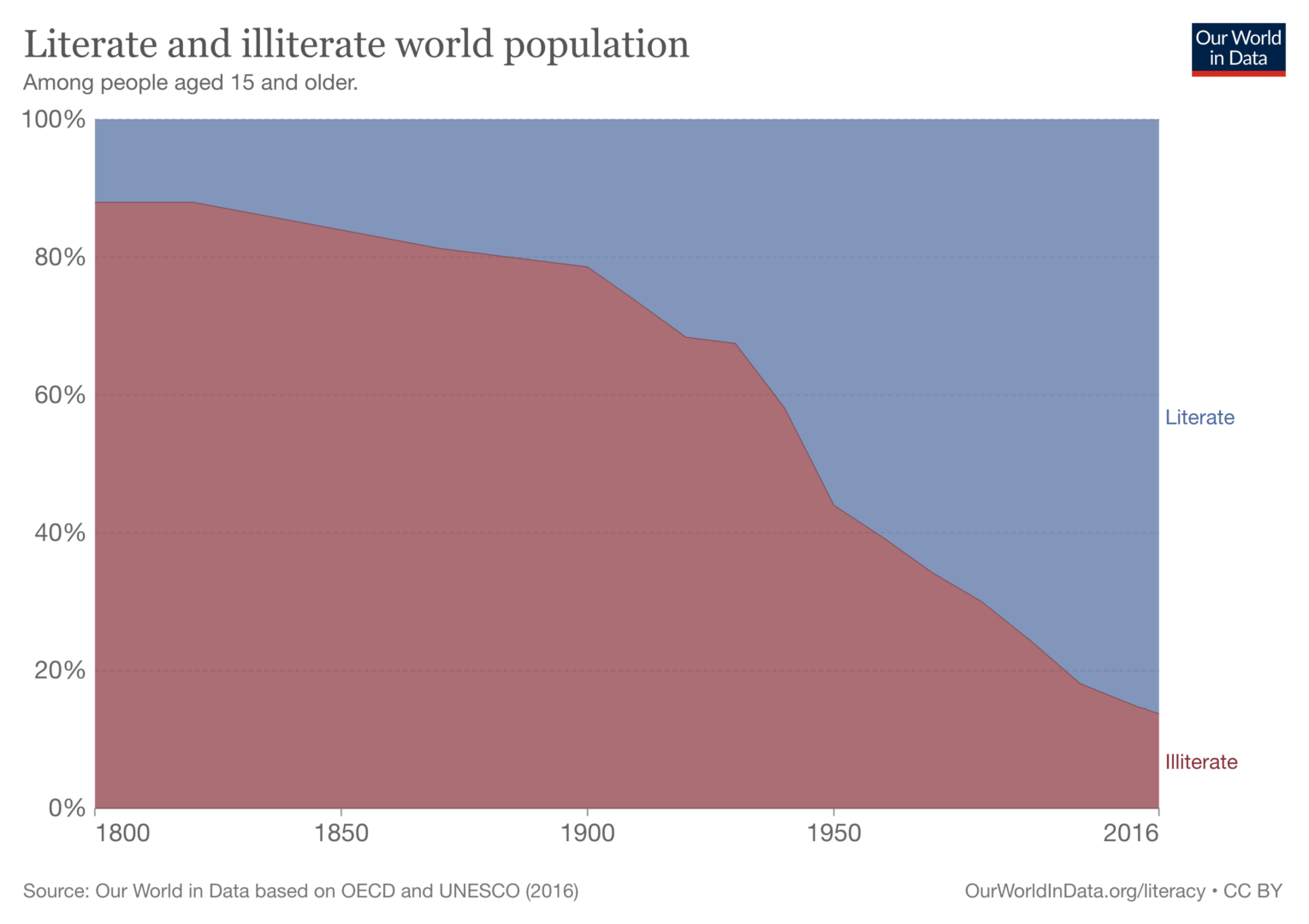
The emergence of the learning society
The information society (circa 1960s) was a period where society was characterized by the widespread use of information and communication technologies (ICT) to drive economic, social, and technological change. This period marked a transition period from manufacturing-based industries to information-based industries – that is, the transition to a post-industrial society. The information society is one marked by the pervasive diffusion of digital technologies such as computers, databases, and networks, as well as satellites and digital communications and transactions. The information society overlapped with Web 1.0 (read-only Web).
The information society eventually morphed into the knowledge society (circa 2000s) – a period characterized by widespread diffusion of knowledge to all members of society. The knowledge society overlaps with Web 2.0 (Social Web) and Web 3.0 (Semantic Web), and as such, allows people to more seamlessly use global social networks for collaboration and learning. The aim of the knowledge society is to improve society by equipping people with anytime, anywhere access to free knowledge to facilitate lifelong and lifewide learning, including such platforms as Open Courseware, Khan Academy, and YouTube, among others. The knowledge society promotes inclusion, education for all, universal access to knowledge, human rights, and sustainable development.
The knowledge society will eventually morph into the learning society (circa 2020s); The learning society is characterized by the seamless integration of formal learning (institutionalized education), nonformal learning (self-directed online instructional videos, audios, webinars, etc.), and informal learning (personal experience, online discussion forums, online communities of practice, etc.). The learning society overlaps with Web 4.0 (Symbiotic Web). In the learning society, learning is not restricted to a physical place or time but rather occurs as an ongoing activity.
In the learning society, the aim is to create human-centered societies that promote a culture of learning through collaboration and partnerships between government, business, and civil society at all levels, thus creating a hyperconnected society. In this society, knowledge will become increasingly fluid and interconnected. At one end, knowledge will become increasingly atomized, making it easier to reuse, share, and repurpose knowledge. On the other end, knowledge will become increasingly aggregated, making it easier to use for artificial intelligence and big data analytics, among other purposes.
The underlying mechanism driving this new paradigm is a virtuous cycle where new knowledge production leads to more knowledge consumption which creates more knowledge. This virtuous cycle will, presumably, speed up as new technological innovations are created, as the shelf-life of knowledge becomes shorter, and as formerly separate knowledge domains like physics, chemistry, biology, and engineering, among others, become more integrated. This phenomenon has huge implications for education at all levels (for example, cross-cutting disciplinary themes, interdisciplinary teaching and learning).
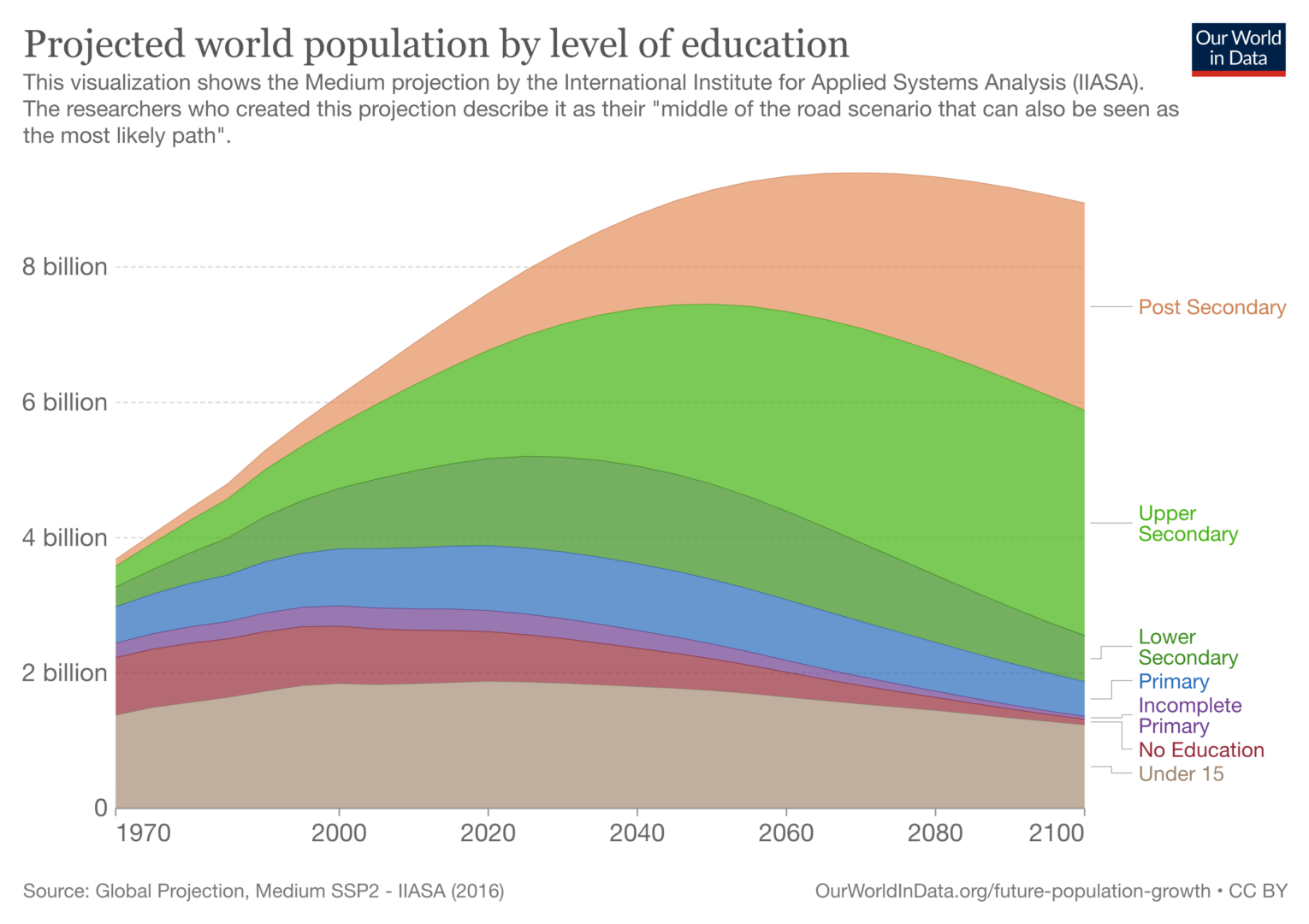
Learning ecosystems
As today’s global knowledge society becomes increasingly interconnected and begins to morph into a global learning society, it is likely that formal, nonformal, and informal learning will become increasingly interconnected. For instance, there has been an explosion of new self-directed e-learning platforms such as Khan Academy, Open Courseware, and YouTube, among others, that help educate billions of people around the world.
A learning ecosystem includes all the elements that contribute to a learner’s overall learning experience. The components of a learning ecosystem are numerous, including people, technology platforms, knowledge bases, culture, governance, strategy, and other internal and external elements that have an impact on learning. Therefore, moving forward, it is crucial to integrate learning across formal, nonformal, and informal learning processes and activities in a more strategic way.
As societies progress, the boundary lines between formal, nonformal, and informal learning will continue to blur as they become more integrated. The quickly developing nonformal and informal learning systems will drive formal learning systems to develop clearer strategies and practices to integrate the different types of learning in more deliberate and effective ways.
Digital technology has driven the massification of nonformal and informal learning just as industrialization and democratization drove the massification of formal learning over the past 200 years. Now, the three major types of learning are being integrated into a more symbiotic learning ecosystem. For instance, Coursera’s100 million learners and Khan Academy’s 135 million learners show the growing influence of nonformal learning. In addition, EdX has over 110 million course enrollments, and YouTube has over a billion people using its platform for educational purposes.
As the demand for modern job skills becomes more fluid, the demand for new ways to learn will also become more fluid. In addition, advances in pedagogical and andragogical science will continue to improve nonformal learning design. Emerging learning ecosystems will have far-reaching impacts and possibilities. Context, culture, and scalability, among other factors, will influence a learning ecosystem’s sustainability, diversity, and dynamism. Learning ecosystems are quickly emerging as technological advances enable integrators to expand and enhance their capabilities. Educational institutions at all levels will use more diverse learning methods to impart knowledge and skills and measure learning outcomes.
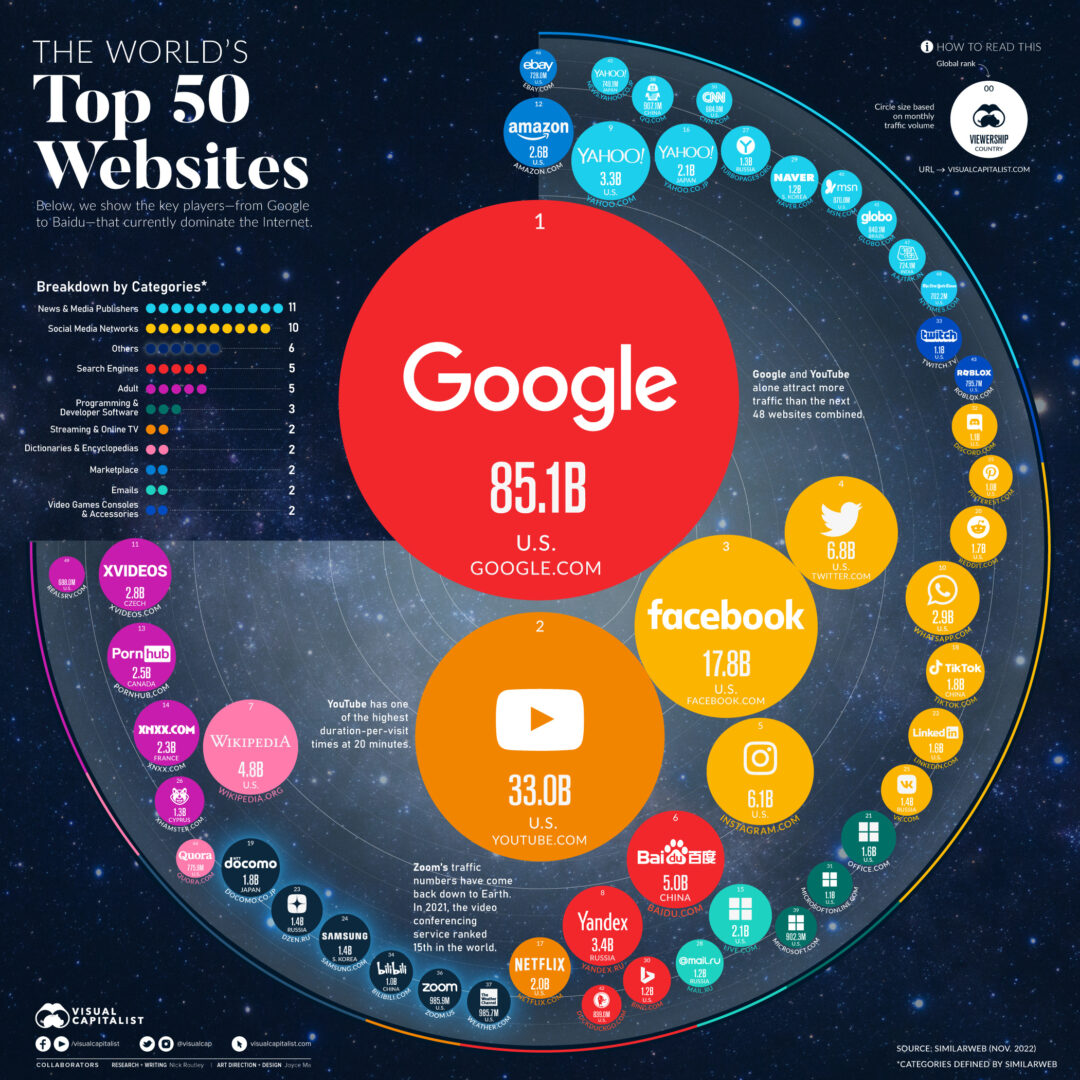
Conclusion
Schools and universities promote formal learning to standardize learning across grades, subjects, and systems. Formal learning refines and regulates education to maximize learning efficiency and effectiveness. Formal learning promotes political stability, economic growth, social mobility, and knowledge sharing, among others. Nonformal learning is organized around learning objectives, but it typically has not been part of the formal curriculum.
Nonformal learning involves learner choice and personalization to give students more freedom to participate in varied learning activities. From a learner’s viewpoint, nonformal learning is intentional and more self-directed. Nonformal learning represents a continued democratization of knowledge where any learner can access knowledge whenever needed.
With nonformal learning, intellectual, emotional, social, and behavioral concerns are of equal importance. The nonformal space refers to learning that takes place outside of a formal curriculum, whereas informal learning takes place outside of the formal classroom. See Figure 1.
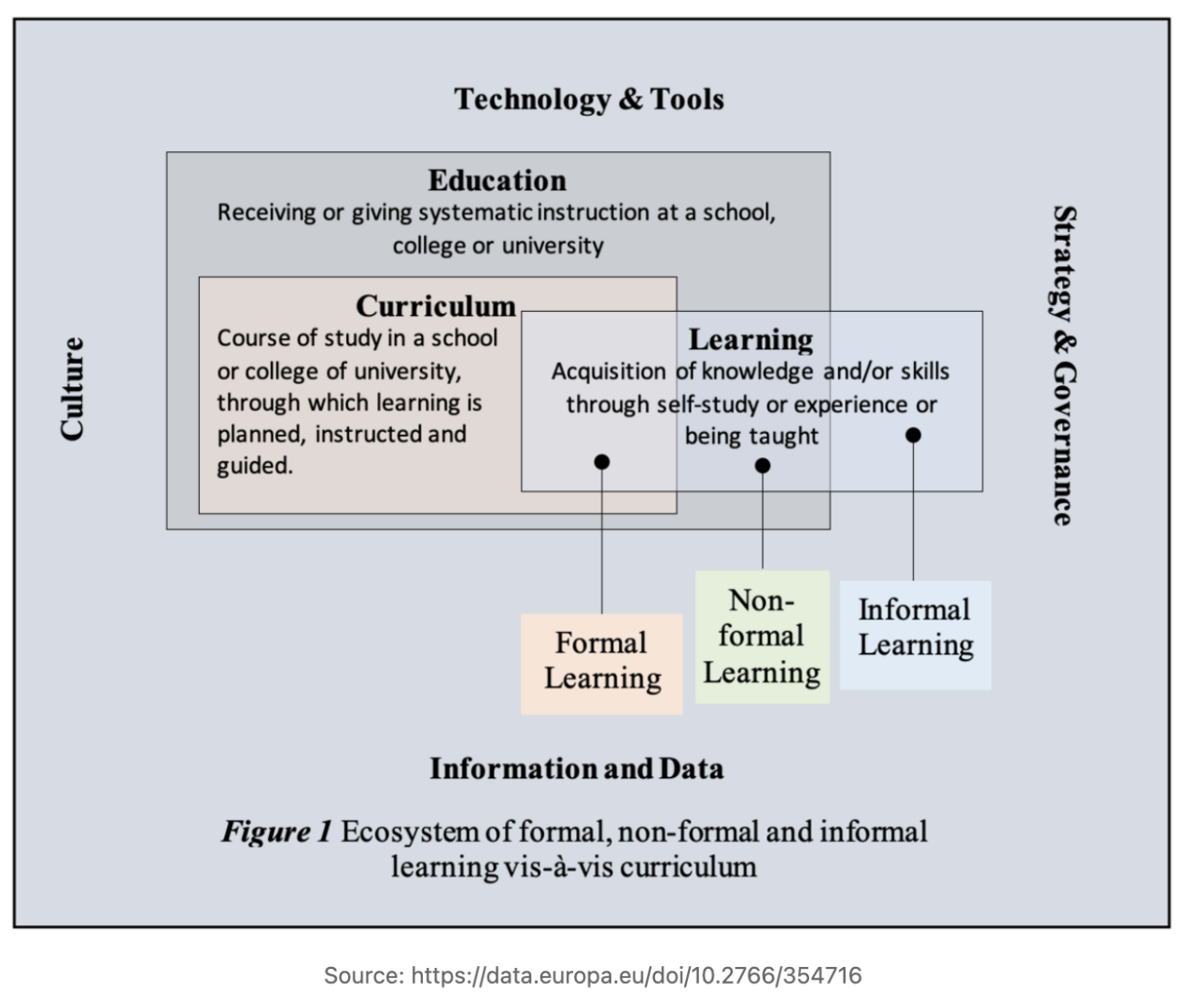
These three types of learning require a broader definition of curriculum, one that takes into account the full range of learning experiences. Integrating all three types of learning can help foster a more effective and sustainable learning ecosystem. Figure 2 illustrates this broader curriculum.
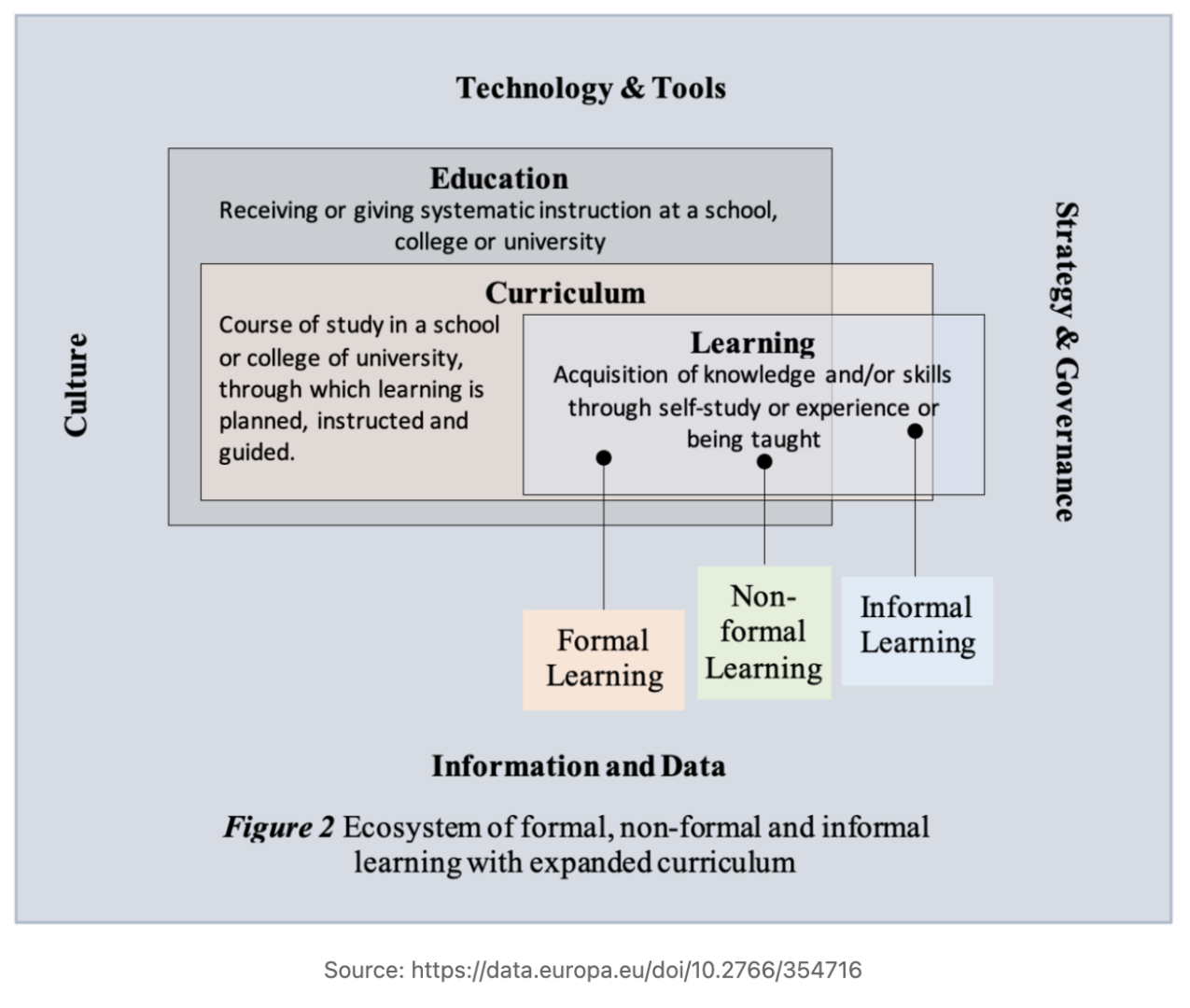
This new approach pushes nonformal and informal learning closer to the educational experience to better support a student’s overall development. This type of sustainable learning ecosystem has the potential to produce a more integrated learning experience for students.
Patrick Blessinger is president and chief scientist for the International Higher Education Teaching and Learning (HETL) Association, USA. Madasu Bhaskara Rao is an Associate Professor in Human Resource Management and Organizational Behaviour at the ICFAI Business School (IBS), a constituent of the Icfai Foundation for Higher Education (IFHE), Hyderabad, India.
Suggested Citation:
Blessinger, P. and Rao, M. B. (2023). Fostering Sustainable Learning Ecosystems, Higher Education Tomorrow, Volume 9, Article 3, https://www.patrickblessinger.com/fostering-sustainable-learning-ecosystems
Copyright © [2023] Patrick Blessinger and Madasu Bhaskara Rao
Disclaimer
Opinions expressed in this article are those of the author, and as such do not necessarily represent the position(s) of other professionals or any institution.
Figures 1 and 2:
European Commission, Directorate-General for Education, Youth, Sport and Culture, Prospective report on the future of non-formal and informal learning: towards lifelong and life-wide learning ecosystems, Publications Office, 2020, https://data.europa.eu/doi/10.2766/354716

